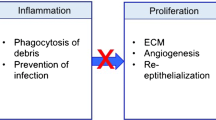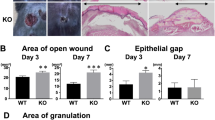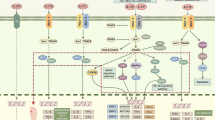Abstract
Background
Recently, we have reported a rapid and strong induction of interleukin-18 (IL-18) upon cutaneous injury in mice. In this paper, we investigated a possible role of IL-18 in triggering interferon-γ (IFN-γ) production at the wound site.
Materials and Methods
Expression of IFN-γ during cutaneous wound healing was analyzed by RNase protection assay, Western blot, ELISA, and immunohistochemical techniques in a murine model of excisional skin repair.
Results
We could not detect any IFN-γ mRNA and protein expression during normal skin repair. Additionally, impaired healing in the genetically diabetic db/db mouse, which was used as a model for a prolonged inflammatory phase of repair, was characterized by largely elevated levels of IL-18 during the late phase of repair and an absence of IFN-γ. Western blot analysis for T-cell- and monocyte/macrophage-specific marker proteins (CD4, F4/80) clearly revealed the presence of these subsets of leukocytic cells at the wound site, that are known to produce IFN-γ in response to IL-18. Furthermore, we provide evidence that the presence of transforming growth factor-β1 (TGF-β1) at the wound site might reflect a counterregulatory mechanism in IL-18-induced IFN-γ production, as TGF-β1 strongly suppressed IL-18/phytohaemagglutinin (PHA)-induced IFN-γ production by peripheral blood mononuclear cells (PBMC) in vitro.
Conclusions
Normal tissue regeneration processes after cutaneous injury were not dependent on the presence of IFN-γ in vivo, and IL-18 must serve additional roles rather than inducing IFN-γ during the healing process.





Similar content being viewed by others
References
Jimenez SA, Freundlich B, Rosenbloom J. (1984) Selective inhibition of human diploid fibroblast collagen synthesis by interferons. J. Clin. Invest. 74: 1112–1116.
Duncan MR, Berman B. (1987) Persistence of a reduced-collagen-producing phenotype in cultured scleroderma fibroblasts after short term exposure to interferons. J. Clin. Invest. 79: 1318–1324.
Czaja MJ, Weiner FR, Eghbali M, Giambrone M, Eghbali M, Zern MA. (1987) Differential effects of gamma-interferon on collagen and fibronectin gene expression. J. Biol. Chem. 262: 13348–13351.
Granstein RD, Flotte TJ, Amento EP. (1990) Interferons and collagen production. J. Invest. Dermatol. 95: 75–80.
Fleischmajer R, Perlish JJ, Duncan M. (1983) Scleroderma: a model for fibrosis. Arch. Dermatol. 119: 957–962.
Murray JC, Pollack SV, Pinnell SR. (1981) Keloids: a review. J. Am. Acad. Dermatol. 4: 461–470.
Symington FW. (1989) Lymphotoxin, tumor necrosis factor, and gamma interferon are cytostatic for normal human keratinocytes. J. Invest. Dermatol. 92: 798–805.
Scheynius A, Fransson J, Johansson C, Hammar H, Baker B, Fry L, Valsimarsson H. (1992) Expression of interferon-gamma receptors in normal and psoriatic skin. J. Invest. Dermatol. 98: 255–258.
Hein R, Behr J, Hundgen M, et al. (1992) Treatment of systemic sclerosis with gamma-interferon. Br. J. Dermatol. 126: 496–501.
Hunzelmann N, Anders S, Fierlbeck G, et al. (1997) Systemic scleroderma. Multicenter trial of 1 year of treatment with recombinant interferon gamma. Arch. Dermatol. 13: 609–613.
Granstein RD, Murphy GF, Margolis RJ, Byrne MH, Amento EP. (1987) Gamma interferon inhibits collagen synthesis in vivo in the mouse. J. Clin. Invest. 79: 1254–1258.
Granstein RD, Deak MR, Jacques SL, et al. (1989) The systemic administration of gamma interferon inhibits collagen synthesis and acute inflammation in a murine skin wounding model. J. Invest. Dermatol. 93: 18–27.
Munder M, Mallo M, Eichmann K, Modolell M. (1998) Murine macrophages secrete interferon-γ upon combined stimulation with interleukin (IL)-12 and IL-18: a novel pathway of autocrine macrophage activation. J. Exp. Med. 187: 2103–2108.
Howie SEM, Aldridge RD, McVittie E, Forsey RJ, Sands C, Hunter JAA. (1996) Epidermal keratinocyte production of interferon-γ immunoreactive protein and mRNA is an early event in allergic contact dermatitis. J. Invest. Dermatol. 106: 1218–1223.
Mosmann TR, Cherwinski H, Bond MW, Giedlin MA, Coffman RL. (1986) Two types of murine helper T cell clone. I. Definition according to profiles of lymphokine activities and secreted proteins. J. Immunol. 136: 2348–2357.
Mosmann TR, Coffman RL. (1989) TH1 and TH2 cells: different patterns of lymphokine secretion lead to different functional properties. Annu. Rev. Immunol. 7: 145–173.
Fishel RS, Barbul A, Beschorner WE, Wasserkrug HL, Efron G. (1987) Lymphocyte participation in wound healing: morphologic assessment using monoclonal antibodies. Ann. Surg. 206: 25–29.
Ross R, Benditt EP. (1962) Wound healing and collagen formation. Fine structure in experimental scurvy. J. Cell Biol. 12: 533–548.
Efron JE, Frankel FL, Lazarou SA, Wasserkrug HL, Barbul A. (1990) Wound healing and T-lymphocytes. J. Surg. Res. 48: 460–463.
Kämpfer H, Kalina U, Mühl H, Pfeilschifter J, Frank S. (1999) Counterregulation of interleukin-18 mRNA and protein expression during cutaneous wound repair in mice. J. Invest. Dermatol. 113: 369–374.
Coleman DL. (1982) Diabetes-obesity syndromes in mice. Diabetes 31: 1–6.
Chen H, Charlat O, Tartaglia LA, et al. (1996) Evidence that the diabetes gene encodes the leptin receptor: identification of a mutation in the leptin receptor gene in db/db mice. Cell 84: 491–495.
Lee GH, Proenca R, Montez JM, Carroll KM, Darvishzadeh JG, Lee JI, Friedman JM. (1996) Abnormal splicing of the leptin receptor in diabetic mice. Nature 379: 632–635.
Chomczynski P, Sacchi N. (1987) Single-step method of RNA isolation by acid guanidinium thiocyanate-phenol-chloroform extraction. Anal. Biochem. 162: 156–159.
Werner S, Peters KG, Longaker MT, Fuller-Pace F, Banda MJ, Williams LT. (1992) Large induction of keratinocyte growth factor expression in the dermis during wound healing. Proc. Natl. Acad. Sci. USA 89: 6896–6900.
Gray PW, Goeddel DV. (1983) Cloning and expression of murine immune interferon cDNA. Proc. Natl. Acad. Sci. USA 80: 5842–5846.
Chu W, Johnson DA, Musich PR. (1992) Molecular cloning and characterization of mouse mast cell chymases. Biochem. Biophys. Acta 1121: 83–87.
Mühl H, Dinarello CA. (1997) Macrophage inflammatory protein-1 alpha production in lipopolysaccharide-stimulated human adherent blood mononuclear cells is inhibited by the nitric oxide synthase inhibitor N(G)-monomethyl-L-arginine. J. Immunol. 159: 5063–5069.
Akira S. (2000) The role of IL-18 in innate immunity. Curr. Opin. Immunol. 12: 59–63.
Wetzler C, Kämpfer H, Stallmeyer B, Pfeilschifter J, Frank S. (2000) Large and sustained induction of chemokines during impaired wound healing in the genetically diabetic mouse: prolonged persistance of neutrophils and macrophages during the late phase of repair. J. Invest. Dermatol. 115: 245–253.
Maddon PJ, Molineaux SM, Maddon DE, et al. (1987) Structure and expression of the human and mouse T4 genes. Proc. Natl. Acad. Sci. USA 84: 9155–9159.
Austyn JM, Gordon S. (1981) F4/80, a monoclonal antibody directed specifically against the mouse macrophage. Eur. J. Immunol. 11: 805–815.
Mizutani H, Schechter N, Lazarus G, Black RA, Kuppers TS. (1991) Rapid and specific conversion of precursor interleukin 1β (IL-1β) to an active IL-1 species by human mast cell chymase. J. Exp. Med. 174: 821–825.
Hazuda DJ, Strickler J, Kueppers F, Simon PL, Young PR. (1990) Processing of precursor interleukin 1β and inflammatory disease. J. Biol. Chem. 265: 6318–6322.
Schonbeck U, Mach F, Libby P. (1998) Generation of biologically active IL-1β by matrix metalloproteinases: a novel caspase-1-independent pathway of IL-1β processing. J. Immunol. 161: 3340–3346.
Martin P. (1997) Wound healing—aiming for perfect skin regeneration. Science 276: 75–81.
Eckes B, Aumailley M, Krieg T. (1996) Collagens and the reestablishment of dermal integrity. In: Clark RAF (ed.) The Molecular and Cellular Biology of Wound Repair. Plenum Press, New York, pp. 493–512.
Frank S, Madlener M, Werner S. (1996) Transforming growth factors β1, β2, and β3 and their receptors are differentially regulated during normal and impaired wound healing. J. Biol. Chem. 271: 10188–10193.
Shah M, Foreman DM, Ferguson MWJ. (1995) Neutralisation of TGF-β1 and TGF-β2 or exogenous addition of TGF-β3 to cutaneous rat wounds reduces scarring. J. Cell Sci. 108: 985–1002.
Welsh MP, Odland GF, Clark RAF. (1990) Temporal relationships of F-actin bundle formation, collagen and fibronectin matrix assembly, and fibronectin receptor expression to wound contraction. J. Cell. Biol. 110: 133–145.
Ignotz RA, Massague J. (1986) Transforming growth factor-β stimulates the expression of fibronectin and collagen and their incorporation into extracellular matrix. J. Biol. Chem. 261: 4337–4340.
Roberts AB, Sporn MB, Assoian RK, et al. (1986) Transforming growth factor β: rapid induction of fibrosis and angiogenesis in vivo and stimulation of collagen formation. Proc. Natl. Acad. Sci. USA 83: 4167–4171.
Schäffer M, Barbul A. (1998) Lymphocyte function in wound healing and following injury. Br. J. Surgery 85: 444–460.
Pollock RE, Babcock GF, Romsdahl MM, Nishioka K. (1984) Surgical stress-mediated suppression of murine natural killer cell cytotoxicity. Cancer Res. 44: 3888–3891.
Blazar BA, Rodrick ML, O’Mahony JB, Wood JJ, Bessey PQ, Wilmore DW, Mannick JA. (1986) Suppression of natural killer-cell function in humans following thermal and traumatic injury. J. Clin. Immunol. 6: 26–36.
DiPietro LA. (1995) Wound healing: the role of the macrophage and other immune cells. Shock 4: 233–240.
Espevik T, Figari IS, Shalaby MR, Lackides GA, Lewis GD, Shepard HM, Palladino MA. (1987) Inhibition of cytokine production by cyclosporin A and transforming growth factor β. J. Exp. Med. 166: 571–576.
Roberts AB. (1995) Transforming growth factor-β: activity and efficacy in animal models of wound healing. Wound Repair Regen. 3: 408–418.
O’Kane S, Ferguson MW. (1997) Transforming growth factor βs and wound healing. Int. J. Biochem. Cell Biol. 29: 63–78.
Sidhu GS, Thaloor D, Singh AK, Raghunath PN, Maheshwari RK. (1996) Enhanced biosynthesis of extracellular matrix proteins and TGF-β1 by polyinosinic-polycytidylic acid during cutaneous wound healing in vivo. J. Cell Physiol. 169: 108–114.
Ghayur T, Banerjee S, Hugunin M, et al. (1997) Caspase-1 processes IFN-γ-inducing factor and regulates LPS-induced IFN-γ production. Nature 386: 619–623.
Gu Y, Kuida K, Tsutsui H, et al. (1997) Activation of interferon-γ inducing factor mediated by interleukin-1β converting enzyme. Science 275: 206–209.
Nakamura K, Okamura H, Wada M, Nagata K, Tamura T. (1989) Endotoxin-induced serum factor that stimulates γ interferon production. Infect. Immunol. 57: 590–595.
Kohno K, Kataoka J, Ohtsuki T, et al. (1997) IFN-γ-inducing factor (IGIF) is a co-stimulatory factor on the activation of Th1 but not Th2 cells and exerts its effects independently of IL-12. J. Immunol. 158: 1541–1550.
Robinson D, Shibuya K, Mui A, et al. (1997) IGIF does not drive Th1 development but synergizes with IL-12 for interferon-γ production and activates IRAK and NFκB. Immunity 7: 571–581.
Puren AJ, Fantuzzi G, Gu Y, Su MS, Dinarello CA. (1998) Interleukin-18 (IFN γ-inducing factor) induces IL-8 and IL-1β via TNF alpha production from non-CD14+ human blood mononuclear cells. J. Clin. Invest. 101: 711–721.
Kremer L, Dupre L, Wolowczuk I, Locht C. (1999) In vivo immunomodulation following intradermal injection with DNA encoding IL-18. J. Immunol. 163: 3226–3231.
Acknowledgments
We thank Nicole Kolb for her excellent technical assistance. We gratefully acknowledge Dr. Martin Kock for his help regarding the animal experiments. This work was supported by a grant of the Adolf Messer-Stiftung.
Author information
Authors and Affiliations
Corresponding author
Rights and permissions
About this article
Cite this article
Kämpfer, H., Paulukat, J., Mühl, H. et al. Lack of Interferon-γ Production Despite the Presence of Interleukin-18 During Cutaneous Wound Healing. Mol Med 6, 1016–1027 (2000). https://doi.org/10.1007/BF03402053
Accepted:
Published:
Issue Date:
DOI: https://doi.org/10.1007/BF03402053




